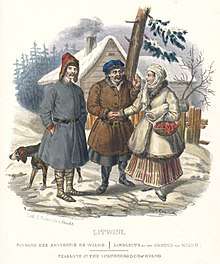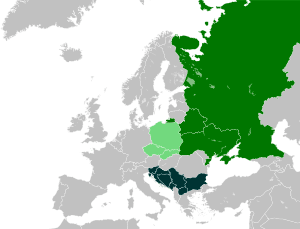Litvin
 | |
| Regions with significant populations | |
|---|---|
| 66[1] | |
| 22[2] | |
| Languages | |
| local dialect | |
In historical context, Litvin (Belarusian: літвін, ліцвін, litvin, litsvin; Lithuanian: lietuvis; Russian: литвин, litvin, Ukrainian: литвин, lytvyn; Polish: Litwin) is a word of Polish descent, which in Polish language means "Lithuanian". Historically was used to refer mostly to ethnic Lithuanians, sometimes to citizens of Grand Duchy of Lithuania of other nations. According to the Statutes of Lithuania, the Grand Duchy of Lithuania was populated with Litvins, Rusyns, and Zmuds (Samogitians) and therefore the full name for the state was the Grand Duchy of Lithuania, Ruthenia, and Samogitia.
The ethnographic or cultural studies about the ethnic group are poorly noted and are traced to the beginning of 18th century.[3] The poet-monk Klymentiy Zinoviyiv who published several works about cultural studies noted that Litvins, perhaps after the older pagan tradition worked on Sundays and rested on Fridays.[3][4] More notes about Litvins were provided at the end of 18th century by historians of the Russian Empire Afanasiy (Opanas) Shafonsky and Yakov Markovych.[3] According to Markovych, Litvins are a special regional group such as Gascoigne in France or Swabians in Germany.[3][5]
Its origin the name Litvin (Litvyak) owes to political and state factors and is a politonym (a name referring to a political group) with reference to the Grand Duchy of Lithuania.[3]
Self name of Litvins in Chernihiv region (Chernihiv Oblast) is Ruski, but not Moskals or Katsaps.[3] The name of Litvins among them is accepted as derogative.[3]
In modern Belarus the word is widely used to describe only Grand Duchy of Lithuania citizens speaking Slavic languages (Ruthenian or Polish), predominantly of Catholic faith and Lithuanian origin or who strongly associated themselves with the state of Lithuania[6][7] identifying themselves with the former Grand Duchy of Lithuania.[8] However, this idea is not accepted by the scientific community.[9]
The term may specifically refer to people speaking Belarusian in historical contexts.[10][9] In other contexts, it can also refer to Slavic people identifying themselves with the former Grand Duchy of Lithuania in present-day Lithuania and Belarus, as well in Ukraine, western Russia and parts of Poland. In modern Belarus, the term is used by some to stress Belarusian participation and contributions to the former Grand Duchy.[9][11]
See also
| Wikimedia Commons has media related to People of Grand Duchy of Lithuania. |
References
- ↑ "Archived copy" (PDF). Archived from the original (PDF) on 2012-02-03. Retrieved 2013-04-17.
- ↑ "Всеукраїнський перепис населення 2001 | Результати | Національний склад населення, мовні ознаки, громадянство | Чисельність осіб окремих етнографічних груп украінського етносу та їх рідна мова | Результат вибору:". 2001.ukrcensus.gov.ua. Retrieved 2016-07-20.
- 1 2 3 4 5 6 7 Horlenko, V. Litvins of the Ukraine North are possibly a fragment of legendary tribe of Siverians (Литвини півночі України - ймовірний уламок племені літописних Сіверян). "Landmarks of Ukraine". 2001.
- ↑ Artifacts of Ukrainian-Ruthenian language and literature / Shevchenko Scientific Society Archaeographic Commission. - Lviv, 1912. - Vol.7. - p.72. (Пам'ятки українсько-руської мови і літератури / Видає археографічна комісія НТШ. - Львів, 1912. - Т.VІІ. - С.72. )
- ↑ Markovych, Ya. Notes about Malorossiya its residents and literary works. - In Saint Petersburg, 1798. (Маркович Я. Записки о Малороссии, ее жителях и произведениях. - В Санкт-Петербурге, 1798.)
- ↑ Jakubowski, Jan, "Studya nad stosunkami narodowoścemi na Litwie przed unią lubelską"
- ↑ Turska, Halina "O powstaniu polskich obszarów językowych na Wileńszczyźnie"
- ↑ https://www.litviny.net/
- 1 2 3 http://www.lituanus.org/1982_1/82_1_03.htm Early Lithuanian grammars
- ↑ Вячаслаў Насевіч. Літвіны Archived 2009-04-01 at the Wayback Machine. // Вялікае княства Літоўскае: Энцыклапедыя. У 2 т. / рэд. Г. П. Пашкоў і інш.Т. 2: Кадэцкі корпус — Яцкевіч. — Мінск: Беларуская Энцыклапедыя, 2005. С. 206—208.
- ↑ "Archived copy". Archived from the original on 2014-04-08. Retrieved 2009-09-07.
External links
- http://www.lituanus.org/1982_1/82_1_03.htm Early Lithuanian grammars
- Стаць Літвінам і быць ім!
- (in Russian) Litvin, I. "Our "Lost world". Selected pages of Belarusian history ("Наш "Затерянный мир". Некоторые страницы белорусской истории").
